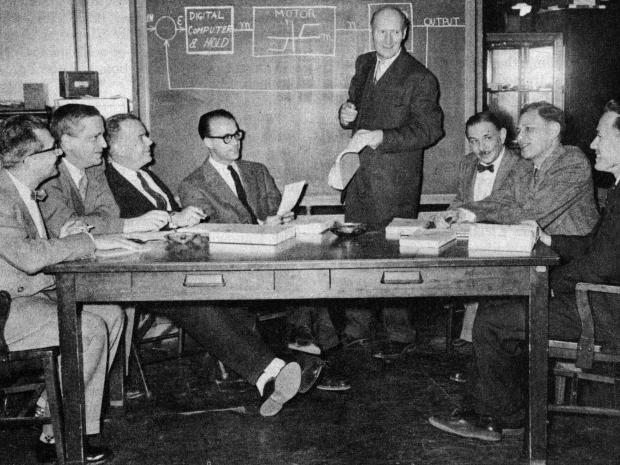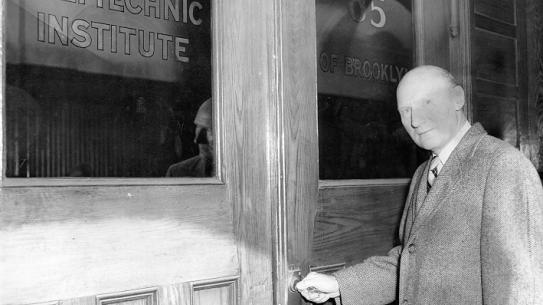Department History

The Polytechnic Institute of Brooklyn (PIB) was chartered in 1854 and in the same year NYU began is first engineering program. In 1973, it acquired the faculty, programs and students of New York University College of Engineering and was renamed Polytechnic Institute of New York. (NYU had been the site for earlier work in 1840 by Samuel F. B. Morse, inventor of the Morse code, and Alfred Vail on a recording telegraph.)
The Electrical Engineering (EE) Program was started at PIB in 1885. The EE Department was formed in 1890. Samuel Sheldon, who served as its head for the first 30 years, was the second president of the American Institute of Electrical Engineers. The first EE degrees were awarded in 1891. Bancroft Gherardi, Jr. was one of the two graduates. He went on to become vice president and chief engineer of AT&T, and to win the IEEE Edison Medal in 1932.
An earlier graduate, Robert G. Brown (class of 1868) designed and developed the first telephone system in Paris, France. Among his other innovations were the "French Telephone," with its separate handpiece (carrying the speaker and microphone) which rested in a cradle, and the hiring of women to work as telephone operators.
NYU awarded its first EE degree in 1926, and Polytechnic began offering part-time evening graduate study programs in that same year. Polytechnic awarded its first Ph.D. degrees in EE in 1937.
Polytechnic's educational and research programs in electrical engineering grew rapidly in scope and quality during the 1940s due to defense technology needs of World War II and the leadership of Ernst Weber, who joined the school after having been educated in Vienna, Austria. Pioneering research, development and production activities for microwave electronics components led to formation of the Polytechnic Research and Development Corp. (PRD) in 1944 and the Microwave Research Institute MRI in 1945. Development of related educational programs grew after Dr. Weber became department head in 1945, leading to the initiation of graduate degrees in Electrophysics in 1960. Dr. Weber also became the first President of the IEEE and a co-founder of the National Academy of Engineering. Research and academic programs in electrophysics enjoyed strong leadership from Herbert Carlin (head of Electrophysics 1961-66), Nathan Marcuvitz (head of MRI 1957-66), Leo Felsen, Arthur Oliner (head of MRI 1967-85, head of EE & EP 1971-74), Theo Tamir (head of EE 1974-79), and Erich Kunhardt (head of MRI 1986-90).

Research in the area of systems and control flourished under the leadership of John Truxal (Department head from 1957-1962). As a result, graduate degrees in Systems Engineering were begun. The most important work in the circuits and systems area was guided by Dante C. Youla, who was awarded the IEEE Control System Field Award in 1988.
The first computer course was offered in 1951. The first leader of computer research and educational programs was Edward Smith, who later served as department head (1967-71, 1979-81). Computer Science degree programs were initiated by faculty forming a division of CS within the EE department. A separate Computer Science Department was formed in 1990.
Telecommunication activities developed significantly after publication of pioneering textbooks by Mischa Schwartz (department head 1962-65) and Athanasios Papoulis. Polytechnic's growing eminence in that field was recognized by the selection in 1983 of its Center for Advanced Technology in Telecommunications for major continuing support from the New York State Science and Technology Foundation. Under the leadership of Richard van Slyke and Ivan Frisch, both developers of networking systems that led to the Internet, CATT developed several related degree programs and made technical contributions to many new firms in that field.
More recent department heads include: Leonard Shaw, 1982-90 (systems and signal processing); Henry Bertoni, 1990-95 (wireless and electromagnetics); Zivan Zabar, 1995-98 (electrical power systems); Unni Pillai, 1998-99 (signal processing); David Goodman, 1999-2001 (wireless networks); Henry Bertoni, 2001-04 (wireless and electromagnetics); H. Jonathan Chao, 2004-2014 (networks); Shivendra S. Panwar, 2014-Present (networks).

